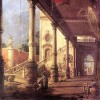Paintings > Art styles > Venetian School
 From the later part of the 15th century, Venice had a distinctive, thriving and influential art scene. Beginning with the work of Giorgione (c. 1477–1510), and the workshop of Giovanni Bellini (c. 1430–1516), major artists of the Venetian school included Titian (1489–1576), Tintoretto (1518–1594), Veronese (1528–1588) and the Bassano (1510–1592). Considered to bring a primacy of color over line, this tradition was seen to contrast with the Mannerism then prevalent in the rest of Italy, and the Venetian style is viewed as having had a great influence on the subsequent development of painting.
From the later part of the 15th century, Venice had a distinctive, thriving and influential art scene. Beginning with the work of Giorgione (c. 1477–1510), and the workshop of Giovanni Bellini (c. 1430–1516), major artists of the Venetian school included Titian (1489–1576), Tintoretto (1518–1594), Veronese (1528–1588) and the Bassano (1510–1592). Considered to bring a primacy of color over line, this tradition was seen to contrast with the Mannerism then prevalent in the rest of Italy, and the Venetian style is viewed as having had a great influence on the subsequent development of painting.The Venetian school had a great influence of subsequent painting, and the history of later Western art has been described as a dialogue between the more intellectual and sculptural/linear approach of the Florentine and Roman traditions, and the more sensual, poetic, and pleasure-seeking of the colourful Venetian school. Specifically through the presence of Titian in Spain, the Venetian style influenced later Spanish art, including that of Velázquez,] and through Rubens was more broadly transmitted through the rest of Europe.
Although not considered part of the Venetian school, it provided the backdrop to 18th-century Venetian painting, which had a final flowering in Tiepolo's decorative painting and Canaletto's and Guardi's panoramic views. The extinction of the Republic by French Revolutionary armies in 1797 effectively brought the distinctive Venetian style to an end; it had at least arguably outlasted its rival Florence in that respect.
Source:Wikipedia
-
 $AU 264.89 ~ 3,908.48
$AU 264.89 ~ 3,908.48 -
 $AU 266.56 ~ 1,140.88
$AU 266.56 ~ 1,140.88 -
 $AU 253.22 ~ 894.34
$AU 253.22 ~ 894.34 -
 $AU 270.41 ~ 2,498.96
$AU 270.41 ~ 2,498.96 -
 $AU 271.87 ~ 1,059.44
$AU 271.87 ~ 1,059.44 -
 $AU 260.04 ~ 1,933.30
$AU 260.04 ~ 1,933.30 -
 $AU 273.35 ~ 1,779.66
$AU 273.35 ~ 1,779.66 -
 $AU 260.76 ~ 961.02
$AU 260.76 ~ 961.02 -
 $AU 251.84 ~ 882.11
$AU 251.84 ~ 882.11 -
 $AU 253.08 ~ 893.06
$AU 253.08 ~ 893.06 -
 $AU 259.00 ~ 945.40
$AU 259.00 ~ 945.40 -
 $AU 704.65
$AU 704.65 -
 $AU 712.61
$AU 712.61 -
 $AU 260.52 ~ 2,193.62
$AU 260.52 ~ 2,193.62 -
 $AU 261.30 ~ 965.88
$AU 261.30 ~ 965.88 -
 $AU 250.08 ~ 2,289.89
$AU 250.08 ~ 2,289.89


